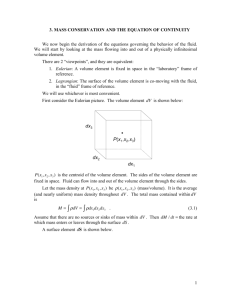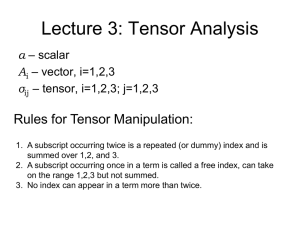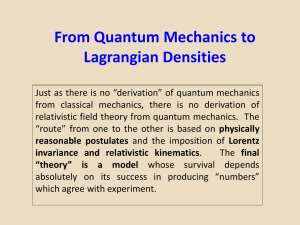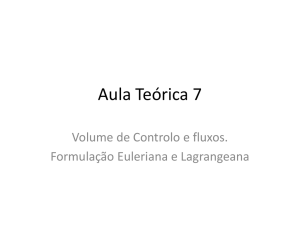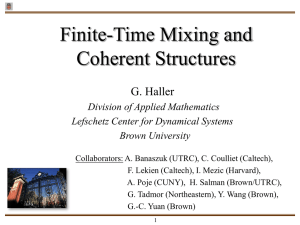Class 6 - Eqns of Motion
advertisement
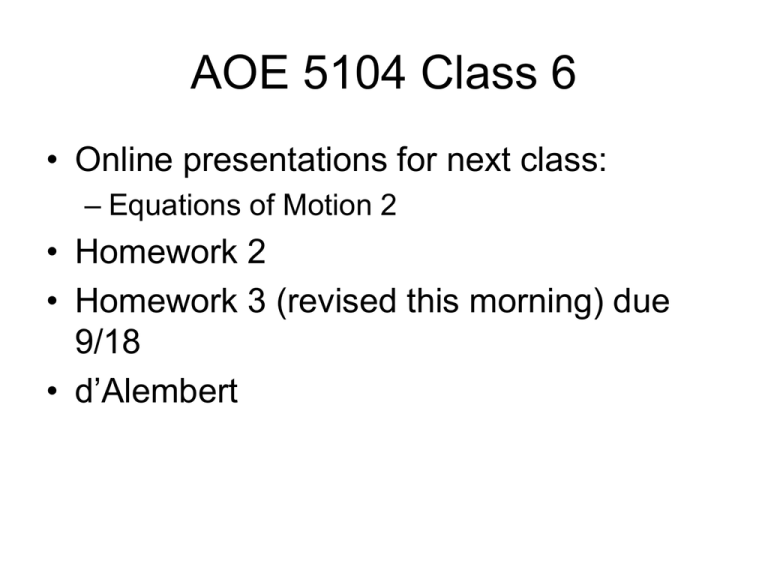
AOE 5104 Class 6 • Online presentations for next class: – Equations of Motion 2 • Homework 2 • Homework 3 (revised this morning) due 9/18 • d’Alembert Last class …and their limitations Integral theorems… d ndS .Ad A.ndS Ad A ndS A.nd S A.ds R S R R C S S S 2D flow over airfoil with =0 C Convective operator… V. = change in density in direction of V, multiplied by magnitude of V Irrotational and Solenoidal Fields… 0 . A 0 Class Exercise 1. Make up the most complex irrotational 3D velocity field you can. V (esin x cos x 2xy3 )i 3x2 y 2 j k / z 2 ? We can generate an irrotational field by taking the gradient of any scalar field, since 0 I got this one by randomly choosing esin x x 2 y3 1/ z And computing V i j k x y z Acceleration?? 2nd Order Integral Theorems • Green’s theorem (1st form) R d S n dS Volume R with Surface S 2 • Green’s theorem (2nd form) 2 2 d R S ndS d - dS n n These are both re-expressions of the divergence theorem. The Equations of Motion “Phrase of the Day” Mutationem motus proportionalem esse vi motrici impressae, & fieri secundum lineam rectam qua vis illa imprimitur. Go Hokies? Supersonic Turbulent Jet Flow and Near Acoustic Field Freund at al. (1997) Stanford Univ. DNS Conservation Laws • Conservation of mass R. O. C. of mass 0 • Conservation of momentum R. O. C. of momentum FBody FPressure FViscous • Conservation of energy R. O. C. of energy WBody WPressure WViscous Q Supersonic Turbulent Jet Flow and Near Acoustic Field Freund at al. (1997) Stanford Univ. DNS Conservation Laws • Conservation of mass R. O. C. of mass 0 • Conservation of momentum R. O. C. of momentum FBody FPressure FViscous • Conservation of energy R. O. C. of energy WBody WPressure WViscous Q Apply to the fluid material (not the space) Experimental observations Assumption: Fluid is a homogeneous continuum DTM Kinematics of Continua z flow 1) Lagrangian Method r xi y j zk Position : x f1 ( xo ,yo, zo , t ) y f 2 ( xo ,yo, zo , t ) ro xoi yo j zok z f 3 ( xo ,yo, zo , t ) y x Velocity : Df ( x ,y z , t ) D vx 1 o o, o where partial derivative wrt time Dt Dt holding ( xo ,yo, zo ) constant vy Df 2 ( xo ,yo, zo , t ) Dt , vz Df 3 ( xo ,yo, zo , t ) Dt DTM Acceleration : ax D 2 f1 ( xo ,yo, zo , t ) Dt 2 , ay D 2 f 2 ( xo ,yo, zo , t ) Dt 2 , az D 2 f 3 ( xo ,yo, zo , t ) Dt 2 Concept is straightforward, but difficult to implement, often would produce more information than we need or want, and doesn't fit the situation usually encountered in fluid mechanics. The Lagrangian Method is always used in solid mechanics : P xo y x xo f1 ( xo , yo , zo , t ), y P t x 6 EI 3 o P xo3 3lxo2 6 EI 3lxo2 f 2 ( xo , yo , zo , t ), z 0 f 3 ( xo , yo , zo , t ) DTM 1) Lagrangian Method Position : x f1 ( xo ,yo, zo , t ) y f 2 ( xo ,yo, zo , t ) z f ( x ,y z , t ) 3 o o, o solve for position as a function of time and “name” Velocity : Df1 ( xo ,yo, zo , t ) vx vy vz Dt Df 2 ( xo ,yo, zo , t ) Dt Df 3 ( xo ,yo, zo , t ) Dt Acceleration : 2 ax ay az D f1 ( xo ,yo, zo , t ) 2 Dt D 2 f 2 ( xo ,yo, zo , t ) Dt 2 D 2 f3 ( xo ,yo, zo , t ) Dt 2 2) Eulerian Method Position : skip this step and do not try to find the positions of fluid particles Velocity : express the velocity as a function of time and spatial position v x ( x, y , z , t ) v y ( x, y, z, t ) v ( x, y , z , t ) z WOW! big, big difference: velocity as a function of time and spatial position, not velocity as a function of time and particle name complication: laws governing motion apply to particles (Lagrange), not to positions in space Acceleration : a t Dv v Grad v v Dt t denotes the derivative wrt time holding the spatial position fixed, often called the “local” derivative DTM Giuseppe Lodovico Lagrangia (Joseph-Louis Lagrange) born 25 January 1736 in Turin, Italy died 10 April 1813 in Paris, France Leonhard Paul Euler born 15 April 1707 in Basel, Switzerland died 18 September 1783 in St. Petersburg, Russia Acceleration in the Eulerian Method: A fluid particle, represented as a blue dot in the figure, z moves from position r to r dr during the time interval dt. dr y r Its velocity changes from v(r, t ) to v(r dr, t dt ) where dr MUST be chosen vdt x a Dv v(r dr, t dt ) v(r, t ) Dt dt Dv v (r dr, t dt ) v (r, t ) v (r dr, t dt ) v (r dr, t ) v (r dr, t ) v(r, t ) Dt dt dt v (r dr, t dt ) v (r dr, t ) v = the derivative wrt time at a fixed location dt t v (r dr, t ) v(r, t ) Grad v dr change in v between two points in space at a fixed time dt dt dt a t and dr are independent variables; so we are free to chose them anyway we want. In order to follow a particle, we must chose dr vdt : a v Grad v v t These equations define a line in terms of the parameter, t , when xo , yo , zo are constant. Such a line is called a pathline. x f1 ( xo ,yo, zo , t ) y f 2 ( xo ,yo, zo , t ) z f ( x ,y z , t ) 3 o o, o . If at a given instant we draw a line with the property that every point on the line passed through the same reference point at some earlier time, the result is known as a streakline. It is called a streakline because, if the particles are dyed as they pass through the common reference point, the result will be a line of dyed particles (i.e., a streak) through the flowfield. If at a given instant the velocity is calculated at all points in the flowfield and then a line is drawn with the property that the velocities of all of the particles lying on that line are tangent to it, the result is known as a streamline. Streamlines are the velocity field lines. They provide a snapshot of the flowfield, a picture at an instant. The surface formed by all the streamlines that pass through a closed curve in space forms a stream tube. Perspectives Eulerian Perspective – the flow as as seen at fixed locations in space, or over fixed volumes of space. (The perspective of most analysis.) Lagrangian Perspective – the flow as seen by the fluid material. (The perspective of the laws of motion.) Control volume: finite fixed region of space (Eulerian) Coordinate: fixed point in space (Eulerian) Fluid system: finite piece of the fluid material (Lagrangian) Fluid particle: differentially small finite piece of the fluid material (Lagrangian) DTM III The Transport Theorem: flow A system moving along in the flow occupies volumes I and II at time t. During the next interval dt some of the system moves out of II into three and some moves out of I into II. The rate of change of an arbitrary property of the system, N, is given by the following: II I N in II at t dt N in II at t N in III at t dt N in I at t DN N in II & III at t dt N in I & II at t Dt dt dt dt dV v ndS t II II the unit vector normal to ABC, the same two material elements, but now approximating the surface of volume III at time = n C’ A’ B’ v dt S C A B material that flowed through the surface of volume II during the interval and now fills volume III: dN vdt n S two triangular elements from the family approximating the surface of volume II at time = t Strategy • Write down equations of motion for Lagrangian rates of change seen by fluid particle or system • Derive relationship between Lagrangian and Eulerian rates of change • Substitute to get Eulerian equations of motion Conservation of Mass From a Lagrangian Perspective Law: Rate of Change of Mass of Fluid Material = 0 For a Fluid Particle: Volume d Density d t d d t part t 1 d d t part t .V t .V For a Fluid System: Volume R d Density =(x,y,z,t) t ‘Seen by the particle’ 0 part 0 part 0 part D is referred to as Dt t part the SUBSTANTIAL DERIVATIVE (or total, or material, or Lagrangian…) where 0 part D 0 Dt d 0 sys R D d 0 Dt R AXIOMATA SIVE LEGES MOTUS • Lex I. – Corpus omne perseverare in statuo suo quiescendi vel movendi uniformiter in directum, nisi quatenus a viribus impressis cogitur statum illum mutare. • Lex II. – Mutationem motus proportionalem esse vi motrici impressae, & fieri secundum lineam rectam qua vis illa imprimitur. • Lex III. – Actioni contrariam semper & æqualem esse reactionem: sive corporum duorum actiones in se mutuo semper esse æquales & in partes contrarias dirigi. • Corol. I. – Corpus viribus conjunctis diagonalem parallelogrammi eodem tempore describere, quo latera separatis. Conservation of Momentum From a Lagrangian Perspective (Fluid Particle) Law: Rate of Change of Momentum = Fbody+Fpressure+Fviscous dV ROC of Momentum t V d t part part DV d Dt k P i Fbody: fd dz j dx dy Net … density volume d velocity V body force per unit mass f Elemental Volume, Surface Forces Sides of volume have lengths dx, dy, dz z, k zy xy xy xy dx y 2 xy dx zy dz z 2 yy dy y 2 p dy p y 2 dy yy yy y 2 p dy p y 2 yy y, j y 2 On front and rear faces y-component x, i zy zy dz z 2 • Volume d = dxdydz • Density • Velocity V Conservation of Momentum From a Lagrangian Perspective (Fluid Particle) Law: Rate of Change of Momentum = Fbody+Fpressure+Fviscous dV ROC of Momentum t V d t part part k DV d Dt P i dz j Fbody: fd dx p p p Fpressure: y com ponent p 12 dy dxdzj p 12 dy dxdzj dj y y y so Fpressure p d dy z, k p dy p y 2 P p p dy y 2 y, j x, i Conservation of Momentum z, k zy zy dz z 2 From a Lagrangian Perspective (Fluid Particle) Law: Rate of Change of Momentum = Fbody+Fpressure+Fviscous ROC of Momentum dV t d part dy V yy yy yd2 t part DV Dt P k P i Fviscous: yy dy y dz 2 j y, j dx Fbody: fd p p p Fpressure: y com ponent p 12 dy dxdzj p 12 dy dxdzj zy ddzj zy y y y z 2 x, i so Fpressure p d yy dy yy 1 yy 1 y com ponent ... yy dy dxdz j yy 2 2 dy dxdzj y y Likewise for xy 1 xy 1 x and z xy 2 dx dydzj xy 2 dx dydzj x x zy zy 12 dz dxdyj zy zy 12 dz dxdyj xy yy zy z z y z x jd Conservation of Momentum From a Lagrangian Perspective (Fluid Particle) Law: Rate of Change of Momentum = Fbody+Fpressure+Fviscous dV ROC of Momentum t V d t part part k DV d Dt P i Fbody: fd So, j dx p p p Fpressure: y com ponent p 12 dy dxdzj p 12 dy dxdzj dj y y y so Fpressure p d Fviscous: dz dy yy 1 yy 1 y com ponent ... yy dy dxdz j yy 2 2 dy dxdzj y y Likewise for xy 1 xy 1 x and z xy 2 dx dydzj xy 2 dx dydzj x x zy zy 12 dz dxdyj zy zy 12 dz dxdyj xy yy zy z z y z x DV f p (.τ x )i (.τ y ) j (.τ z )k Dt where τ x xxi yx j zx k τ y xyi yy j zy k τ z xz i yz j zz k jd AXIOMS CONCERNING MOTION • Law 1. – Every body continues in its state of rest or of uniform motion in a straight line, unless it is compelled to change that state by forces impressed upon it. • Law 2. – Change of motion is proportional to the motive force impressed; and is in the same direction as the line of the impressed force. • Law 3. – For every action there is always an opposed equal reaction; or, the mutual actions of two bodies on each other are always equal and directed to opposite parts. • Corollary 1. – A body, acted on by two forces simultaneously, will describe the diagonal of a parallelogram in the same time as it would describe the sides by those forces separately. Isaac Newton 1642-1727 Conservation of Energy From a Lagrangian Perspective (Fluid Particle) Law: Rate of Change of Energy = Wbody+Wpressure+Wviscous+Q ROC of Energy Wbody f.Vd d (e 12 V 2 ) t part D(e 12 V 2 ) d Dt k P i dz j dx dy • Total energy is internal energy + kinetic energy = e + V2/2 per unit mass • Rate of work (power) = force x velocity in direction of force • Fourier’s law to gives rate of heat added by conduction Elemental Volume, Surface Force Work and Heat Transfer Sides of volume have lengths dx, z, k y-contributions T k y dy T k y y 2 p dy p y 2 v dy v y 2 T k y dy T k y y 2 p dy p y 2 v dy v y 2 Viscous work requires expansion of v velocity on all six sides dy, dz y, j x, i Velocity components u, v, w • Volume d = dxdydz • Density • Velocity V Conservation of Energy From a Lagrangian Perspective (Fluid Particle) Law: Rate of Change of Energy = Wbody+Wpressure+Wviscous+Q ROC of Energy d (e 12 V 2 ) t part D(e 12 V 2 ) d Dt Wbody f.Vd Wpressure .( pV) d Wviscous (.(uτ x ) .(vτ y ) .(wτ z ) )d Q: T T 1 T T 1 T 2 dy dxdz k 2 dy dxdz k d y contribution k k k y y y y y y y y so Q .(kT ) d So, D(e 12 V 2 ) f .V .( pV) .(uτ x ) .(vτ y ) .(wτ z ) .(kT ) Dt Equations for Changes Seen From a Lagrangian Perspective Differential Form (for a particle) D .V Dt DV f p (.τ x )i (.τ y ) j (.τ z )k Dt D(e 12 V 2 ) f .V .( pV) .(uτ x ) .(vτ y ) .(wτ z ) .(kT ) Dt D Integral Form (for a system) d = 0 Dt R D V d = f d - pn dS + ( τ x .n ) i + ( τ y .n )j + ( τ z .n )k dS Dt R R S S 2 D V (e + ) d = V.f d + - pn + (τ x .n) i (τ y .n) j + (τ z .n) k .V dS + k( T).n dS Dt R 2 R S S Conversion from Lagrangian to Eulerian rate of change - Derivative t D The Substantial Derivative Dt x y z u v w t x t y t z t t x y z V. t part y Time Derivative Convective Derivative x (x(t),y(t),z(t),t) z Conversion from Lagrangian to Eulerian rate of change - Integral t D D d d R Dt Dt R D Dd d Dt Dt R D d .Vd Dt R V . . V d t R .( V ) d t R α d V.ndS t R S d = sys R D V. Dt t Apply Divergence Theorem The Reynolds Transport Theorem y x z Volume R Surface S Equations for Changes Seen From a Lagrangian Perspective D .V Dt D Dt t part Differential Form (for a particle) DV f p (.τ x )i (.τ y ) j (.τ z )k Dt D(e 12 V 2 ) f .V .( pV) .(uτ x ) .(vτ y ) .(wτ z ) .(kT ) Dt D Integral Form (for a system) d = 0 Dt R D V d = f d - pn dS + ( τ x .n ) i + ( τ y .n )j + ( τ z .n )k dS Dt R R S S 2 D V (e + ) d = V.f d + - pn + (τ x .n) i (τ y .n) j + (τ z .n) k .V dS + k( T).n dS Dt R 2 R S S Equations for Changes Seen From an Eulerian Perspective D .V Dt D V. Dt t Differential Form (for a fixed volume element) DV f p (.τ x )i (.τ y ) j (.τ z )k Dt D(e 12 V 2 ) f .V .( pV) .(uτ x ) .(vτ y ) .(wτ z ) .(kT ) Dt Integral Form (for a system) d V. n dS = 0 R t S V R t d V(V.n)dS = R f d - S pn dS + S ( τ x .n ) i + ( τ y .n )j + ( τ z .n )k dS (e + 12 V 2) 2 R t ) d S (e + 12 V )V.ndS = R V.f d + S - pn + (τ x .n) i (τ y .n) j + (τ z .n) k .V dS + S k( T).n dS Equivalence of Integral and Differential Forms Cons. of mass (Integral form) R t d S V.ndS = 0 Divergence Theorem V.ndS = . V d R S Conservation of mass for any volume R R t . V d 0 Then we get . V 0 t Cons. of mass (Differential form) D .V Dt or V. .V 0 t
